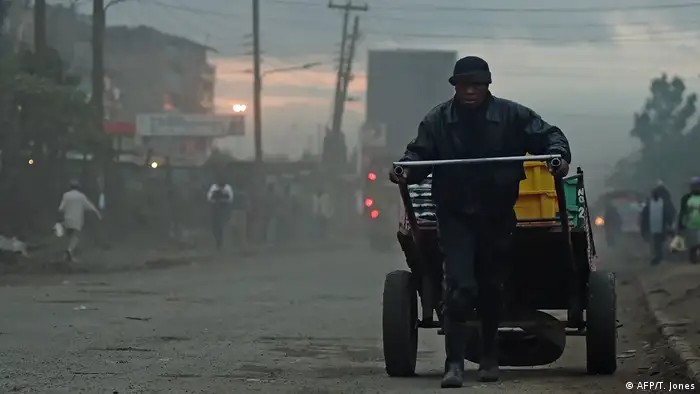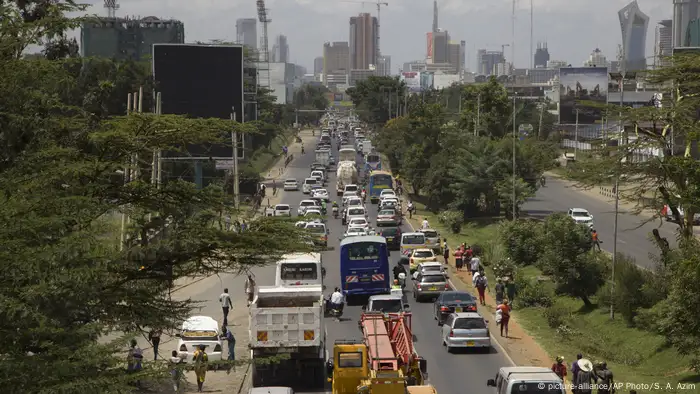Data Journalism
Struggling to breathe: Using sensors to find air pollution hotspots in Nairobi
The founders of Nairobi-based Odipo Dev, Odanga Madung and Samer Ahmed are DW Akademie Dataship fellows. Odanga Madung explains their project on the effect of air pollution in the Kenyan capital Nairobi.
Odanga Madung is a data scientist, journalist and co-founder of Odipo Dev, an organization that specialises in data analysis and visualization.
DW Akademie: Why did you choose air pollution as your project focus?
Odanga Madung: We consistently monitor health statistics coming from the Kenyan government and one of the main things that we noticed is that, in the recent past, pneumonia and other respiratory diseases were the number one killer in Kenya. Many of the people we talked to mentioned that this was due to our growing air pollution problem. However, it was really hard to get a clear picture of the ways in which we were vulnerable, what the trends in pollution were and how communities were affected. With this in mind we pitched our project to DW and they decided to go ahead and fund it.
What is the air pollution situation like in Kenya?
The air pollution situation in Kenya varies between rural and urban areas.
The majority of the air pollution in urban centers in Kenya is outdoor pollution. We would say it’s only recently that Kenyans also began to understand how bad our air pollution is. Because of the coronavirus and the reduced movement of the population in Nairobi and factories closing, Mount Kenya — much to the disbelief of many people — is actually visible from some sections of the city. Something that many people have actually refused to believe, but has now been confirmed to be true.
In rural areas however, it’s a much different story. The predominant air-pollution is indoor. This is due to the usage of fuel sources such as charcoal and firewood. This often causes vulnerable groups (women and children) that carry out household chores to develop lung complications much more easily.
What was the aim of your project?
To enable our readers to develop a clear understanding of outdoor air pollution in Nairobi. To show them what causes it, what its trends are, which entities or persons are making it worse and the effect of all this on their own health.
What were the major findings?
Investigating this made us realize that Nairobi’s air pollution problem is the result of a broken system. One that enables an inefficient transport system with poorly designed roads and old inefficient cars to run on the roads releasing harmful exhaust fumes into the air. That inefficient transport system leads to traffic jams, which we discovered are the major contributor to Nairobi’s pollution problem. However, the effect of all these cars we’re importing is an afterthought in terms of how our authorities think about policy.
Air pollution in the minds of many is still mostly about emissions from factories. In many communities grappling with emission problems, the presence of traffic compounds it many times over during peak commuting hours. Our broken systems have led to poor urban planning which lets rogue businesses erect factories and building anywhere they wish, the result of which has seen businesses setting up factories that emit sulfuric gasses right outside marked residential areas. In one of the residential areas that we measured where such a thing happened, the levels of air pollution were consistently above the healthy limit, residents would wake up and find black soot on their cars and kitchen sinks, one person in that community even lost a child due to respiratory complications.
This even spills over into how we treat those who are affected by respiratory diseases. One of the most shocking things we came across in our research was how many women in some of the slums we studied gave birth to underweight children, something that researchers have linked to the air pollution happening in their areas. It dawned on us that unless we rethink how we interact with our environment on a very basic level, some of our streets could be covered in smog in the next few years.
What data were you working with and how did you collect it?
Data was acquired with the help of our partners in the Sensors.Africa project (a Code for Africa Initiative). Sensors installed all over Nairobi were used to remotely capture and stream PM2.5 and PM10 values (particles smaller than 2.5 and 10 micrometers in diameter) in their environments for over a year, after which analysis was done to determine air pollution levels in the respective areas.
How did your project help the community?
Our story highlighted the plight of the various communities that we covered to a nationwide audience. We’ve had many of our readers reach out and tell us that they’ve taken measures to reduce their interactions with air pollution at this time such as using alternative transport solutions and wearing things such as masks. People in various communities where atrocities have occurred — such as factories being built near their houses — now tell us they have evidence that enables their advocacy.
What stories are data journalists in Kenya telling that otherwise might not be told?
Data journalism is enabling Kenyan journalists to add more nuance to the stories that they’re telling and show audiences the drastic extent to which a lot of issues have gotten out of hand. This is especially true in environmental and supply chain investigations. Domains which Kenyan audiences rarely get a glimpse into. Kenyan journalists are using data journalism methods to expose things like the extent to which the water they drink is polluted, the extent to which the meat and flour they consume is contaminated, and why cholera outbreaks keep happening in the country. Even right now, the coronavirus coverage that we are seeing is largely driven by data journalism methods and principles in Kenyan newsrooms.
Odanga Madung and his project partner Samer Ahmed's Dataship work was published in the Kenyan newspaper Daily Nation.
- Date 21.05.2020
- Author Odanga Madung
- Feedback: Send us your feedback.
- Print Print this page
- Permalink https://p.dw.com/p/3caTj
- Date 21.05.2020
- Author Odanga Madung
- Send us your feedback.
- Print Print this page
- Permalink https://p.dw.com/p/3caTj



